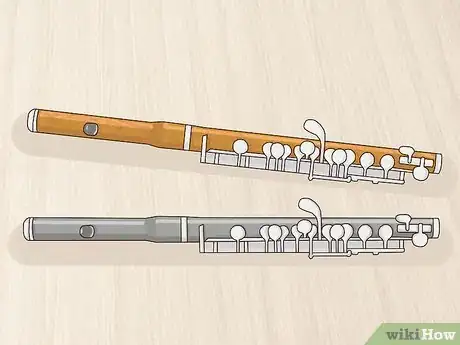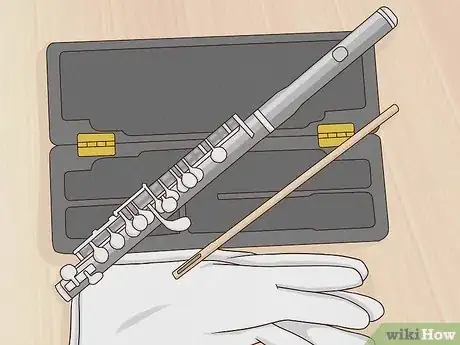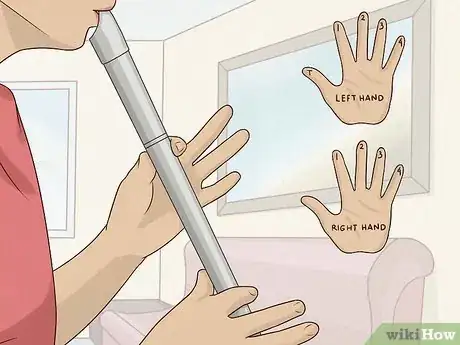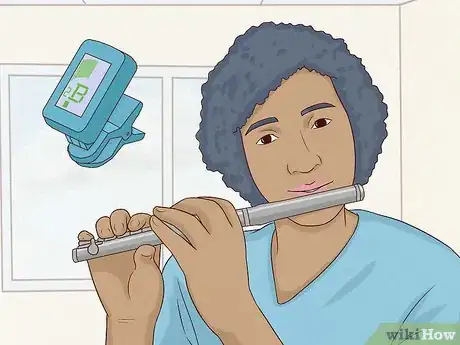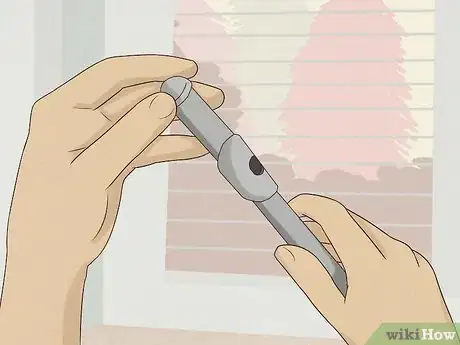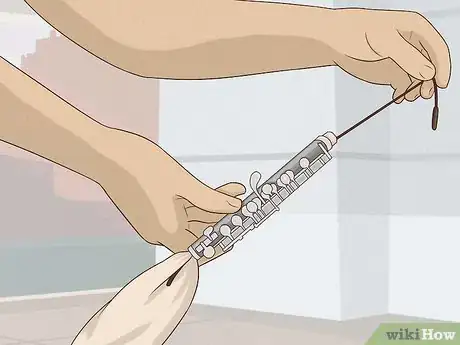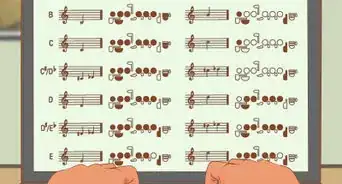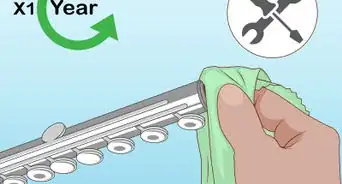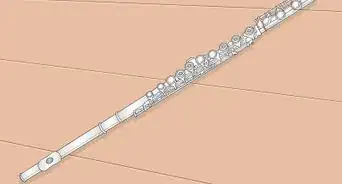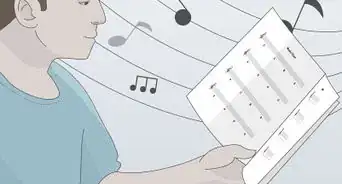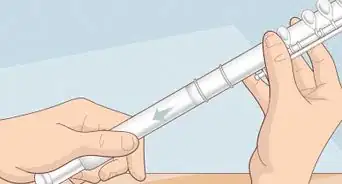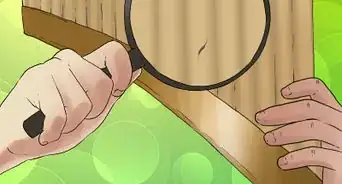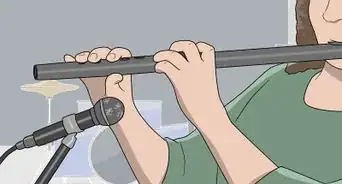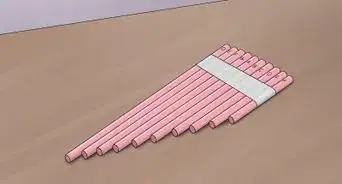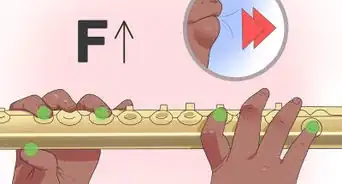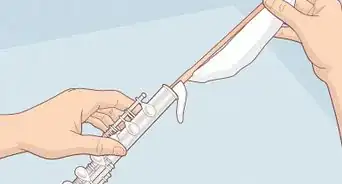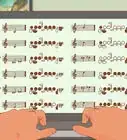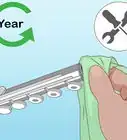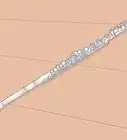wikiHow is a “wiki,” similar to Wikipedia, which means that many of our articles are co-written by multiple authors. To create this article, 38 people, some anonymous, worked to edit and improve it over time.
This article has been viewed 193,628 times.
Learn more...
The piccolo is an instrument constructed of wood or plastic, and silver, or a combination of these materials. It is a half-sized flute, playing the higher range of notes. And while the piccolo is used mainly in orchestral pieces, there are a few pieces written specifically for it.
When learning to play the piccolo, you'll learn that although the fingerings are the same as the flute, the embouchure and other differences do require a separate effort to learn. This guide will outline the basics for getting started in playing this lively instrument.
Steps
-
1Learn to play the flute. The piccolo is very similar and you should learn how to play flute first. If you play in a band or orchestra, it's probable that you won't be playing piccolo all the time, depending on the types of pieces the ensemble plays, so having the versatility to be able to play the flute as well is important.[1]
-
2Choose a piccolo according to where you will be using it and your level of proficiency. Plastic or silver-plated metal piccolos are less expensive than wood or silver piccolos. Piccolos made of composite plastic are durable enough for marching and produce a fair quality sound. Wooden piccolos offer a more mellow timbre than metal ones. A popular compromise combines a metal head joint with a body made from wood. Two materials combined may lead to tuning inconsistencies, however, as they will react differently to changing temperatures.
- Keep in mind there are different keys the piccolo is tuned in. C is the most common, but many older piccolos are in Db. It is recommended you choose a C piccolo, as you can just play the flute part. Db parts aren't common, but you can find them in older pieces.
Advertisement -
3Gather the needed accessories from the Things You'll Need section below.
-
4Consider paying for a flute teacher who also plays piccolo to give you private lessons. This resource will be very important as you learn to play.
-
5Learn the range of a piccolo. Flute fingerings will produce the same notes on a piccolo, only an octave higher. Music is written one octave below concert pitch. It may take time to become accustomed to the notes you play and the ones on the page.
-
6Become familiar with playing your major, minor, and chromatic scales.[2]
-
7Try practicing with an electric tuner in front of you. See you how long you can hold a note steady and try to be consistently in tune. Also, see what the tendencies of certain notes are on your piccolo- flat? sharp? in tune?[3]
-
8Tune before you play. Tune to an A. If the tuner says you are sharp (moves to the right), pull out the head joint. If you are flat (tuner will move to the left), push in the head joint. The piccolo is a small and fickle instrument, so be prepared to make constant small adjustments! Try tuning to the low and high A. Piccolos cannot tune as effectively to concert F or B flat, which is often played for tuning in large ensembles.
-
9Practice often. Others may find the piercing sound of a learner on the piccolo aggravating, so try practicing in a closed room. Just make sure wherever you practice is large and has decent acoustics.[4]
-
10Clean your piccolo thoroughly after playing. Use a swab or string a cloth through your tuning rod and then through your piccolo to remove spit. Occasionally polish it with a cloth.[5]
Community Q&A
-
QuestionHow do I make a sound?
 Community AnswerIf you are unable to make a sound in your piccolo, consider doing this: Make your fingers in a "2" shape, then put the horizontal under your lower lip, then blow out of your mouth, adjusting your lips until you feel air on the finger farthest away from you.
Community AnswerIf you are unable to make a sound in your piccolo, consider doing this: Make your fingers in a "2" shape, then put the horizontal under your lower lip, then blow out of your mouth, adjusting your lips until you feel air on the finger farthest away from you. -
QuestionHow do I play a note on the piccolo without making it sound airy?
 Community AnswerThe simple answer is to practice supporting your sound and breath. Focus the air you blow into the embouchure hole, support your sound using your breath and stomach, and the easiest solution: practice!
Community AnswerThe simple answer is to practice supporting your sound and breath. Focus the air you blow into the embouchure hole, support your sound using your breath and stomach, and the easiest solution: practice! -
QuestionHow do I polish a woodwind instrument?
 Community AnswerIf you have a cloth in your carry case or bought a cleaning set, you should have a white cloth, which can is used to put up the instrument to clean the inside. The velvet-feeling cloth is used to polish the silvery outside.
Community AnswerIf you have a cloth in your carry case or bought a cleaning set, you should have a white cloth, which can is used to put up the instrument to clean the inside. The velvet-feeling cloth is used to polish the silvery outside.
Warnings
- Flute players with large fingers may find it difficult to press the smaller piccolo keys accurately.⧼thumbs_response⧽
- The piccolo is somewhat notorious for being difficult to play in tune. Its small size makes it difficult to construct completely in tune and causes what would be small pitch variances in larger instruments to become rather significant. The fact that it is so high does not help, as it is rather conspicuous when out of tune.⧼thumbs_response⧽
- The intonation for notes on the piccolo is not necessarily the same as the flute. For instance, the middle D# is notoriously flat on flute but it is sharp on the piccolo. Instead of just trusting your flute instincts, sit down with a tuner and figure out the intonation for your piccolo.⧼thumbs_response⧽
- Be careful when cleaning or assembling your piccolo. Be gentle and do not twist keys or rub pads. If your piccolo is malfunctioning take it to a music shop to be fixed.⧼thumbs_response⧽
- Though flute fingerings work for most notes on the piccolo, some notes (especially high notes) have special piccolo fingerings. Lookup a piccolo fingering chart and try them out!⧼thumbs_response⧽
- If you have a wooden piccolo do not blow into it to warm it up. This can cause the wood to crack! Instead, use your hands to warm it up if it's cold.⧼thumbs_response⧽
Things You'll Need
- Piccolo
- Case
- Tuning rod
- Small silk or cotton cloth or a swab
- Electronic tuner/metronome (optional)
- Polishing cloth (optional)
- Cork grease (For piccolos with cork at the end of the body meeting the head joint)
- Oil
References
- ↑ https://nafme.org/ten-tips-to-transform-a-flutist-into-a-piccoloist/
- ↑ https://www.daviderato.com/blog/2015/8/19/piccolo-tips-from-the-pros
- ↑ https://nafme.org/ten-tips-to-transform-a-flutist-into-a-piccoloist/
- ↑ https://www.daviderato.com/blog/2015/8/19/piccolo-tips-from-the-pros
- ↑ https://www.youtube.com/watch?v=avh-how7KR4
- Wikipedia:Piccolo

